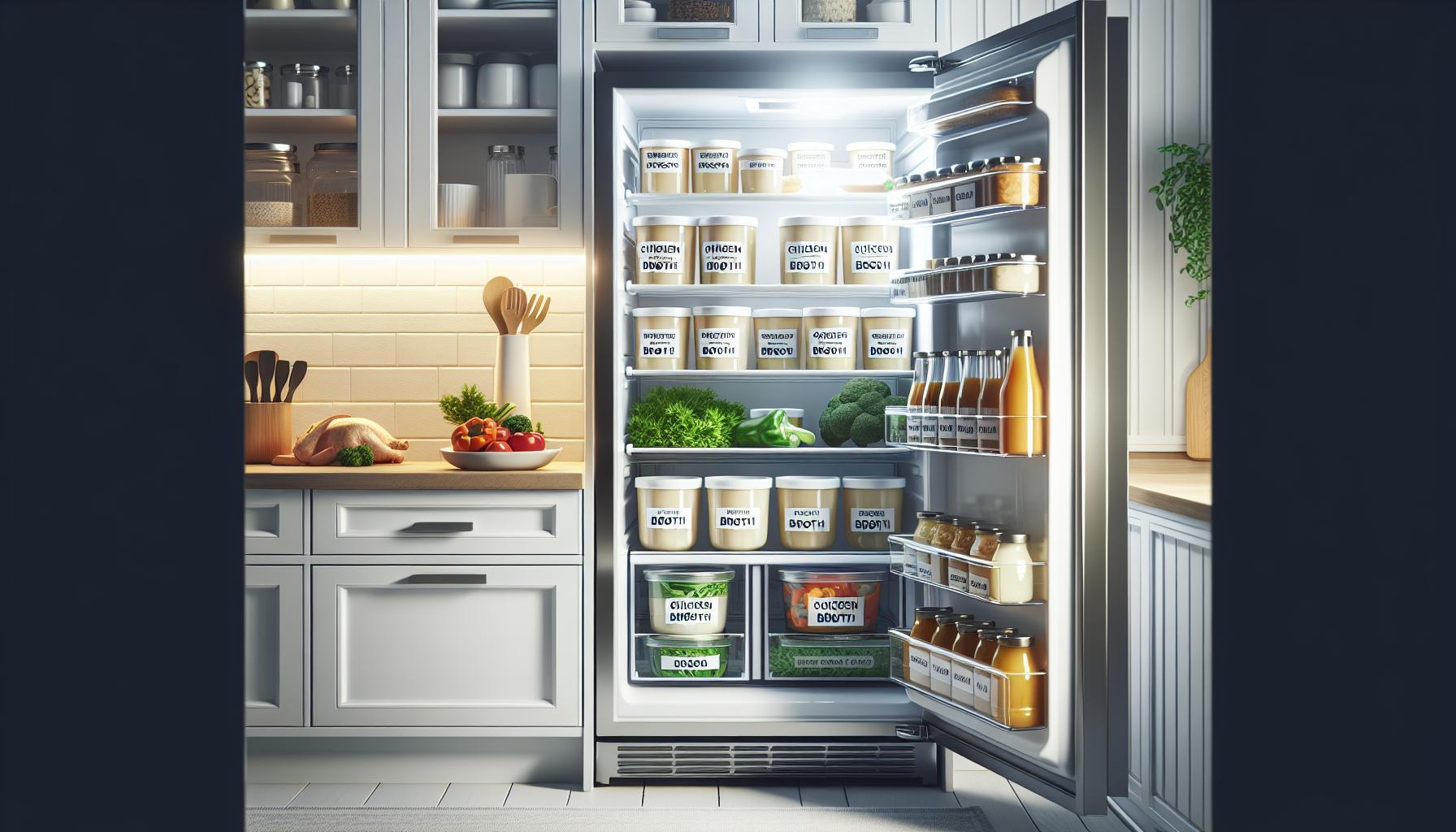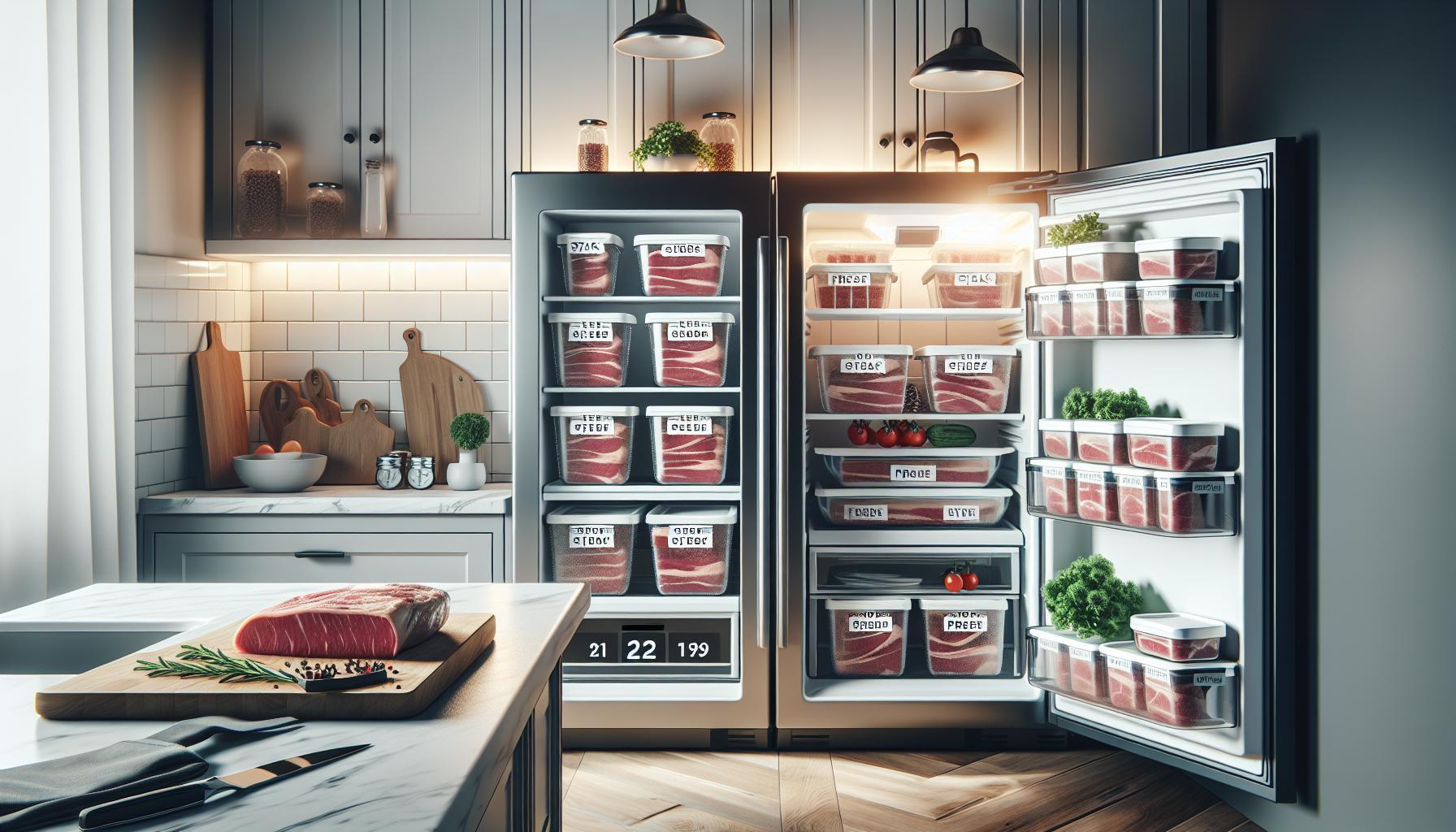When it comes to enjoying chicken wings, knowing how long they can last in the fridge is crucial for food safety and quality. Did you know that improperly stored wings can quickly spoil and become a breeding ground for bacteria? It’s essential for every wing lover to understand safe storage practices to ensure delicious meals while avoiding foodborne illnesses.
In this guide, we’ll explore the lifespan of chicken wings in the refrigerator, provide valuable storage tips, and share best practices to keep your wings fresh and tasty. Whether you’re saving leftovers from game day or prepping for a family gathering, understanding how to handle your chicken wings properly will allow you to enjoy them to the fullest, while keeping safety as the top priority. Keep reading to learn how to maximize both flavor and safety!
How Long Do Chicken Wings Last in the Fridge?
Properly storing chicken wings is essential to maintain their quality and safety. When kept in the refrigerator, cooked chicken wings can last for about 3 to 4 days. If you’re dealing with raw chicken wings, the recommended storage time is shorter-typically 1 to 2 days before they should be cooked or frozen. It’s important to ensure that your refrigerator is set to a temperature of 40°F (4°C) or lower, as this helps inhibit the growth of harmful bacteria.
To extend the lifespan of your chicken wings beyond the refrigerator, consider freezing them. When properly stored in airtight packaging, raw chicken wings can last in the freezer for up to 9 months, while cooked wings can safely be frozen for about 4 months. Always label your packaging with the date of freezing to keep track of storage times and ensure you’re using them while they are still at their best quality.
For those wondering about signs of spoilage, pay attention to any off smells, discoloration, or a slimy texture. If any of these indicators are present, it’s safest to discard the wings to avoid the risk of foodborne illness. Storing chicken wings safely is crucial not just for taste but also for health, so adhering to these guidelines can help ensure your meals are both delicious and safe.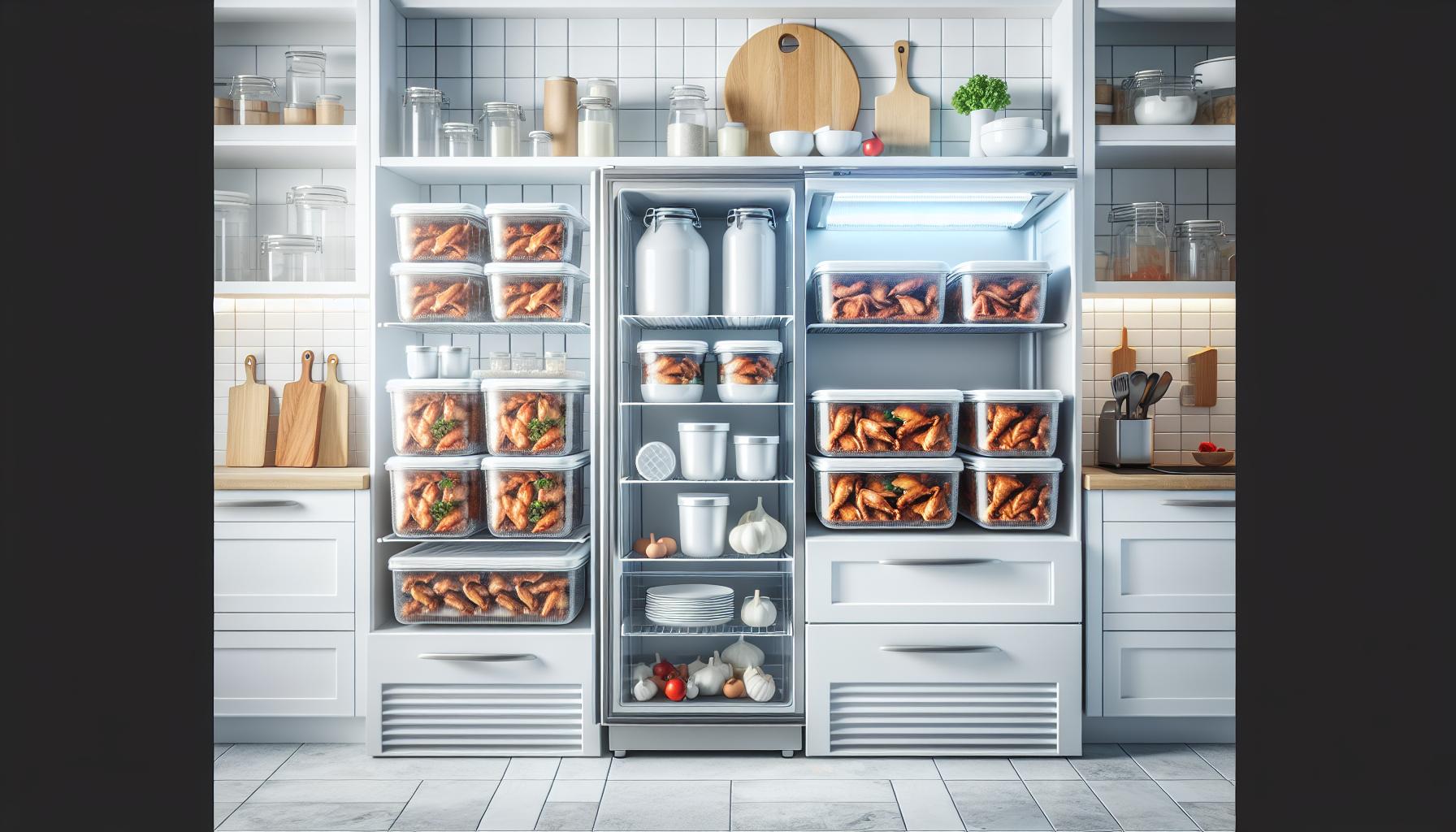
Understanding Chicken Wing Storage Guidelines
To enjoy chicken wings safely, understanding how to store them appropriately is crucial. The right practices can prevent spoilage and foodborne illnesses, ensuring your meals are both delicious and safe. When stored in the refrigerator, cooked chicken wings typically remain safe to eat for about 3 to 4 days. If you have raw wings, their shelf life is shorter-generally 1 to 2 days-before cooking or freezing is recommended. Always make sure your refrigerator is set to 40°F (4°C) or lower to inhibit the growth of harmful bacteria.
For optimal storage, keep chicken wings in airtight containers or tightly sealed plastic wrap. This minimizes exposure to air, which can lead to freezer burn and compromise quality if you choose to freeze them. When freezing, raw chicken wings can remain good for up to 9 months in a well-sealed package, while cooked wings can be frozen safely for around 4 months. It’s a good practice to label your packaging with the freezing date to keep an eye on the age of your wings, helping you to use them while they are still in their prime condition.
Following these guidelines helps to ensure that you’re making the most of your chicken wings. Implementing proper storage techniques not only maintains their quality but also significantly reduces the risk of spoilage, allowing you to enjoy your favorite dishes without worry.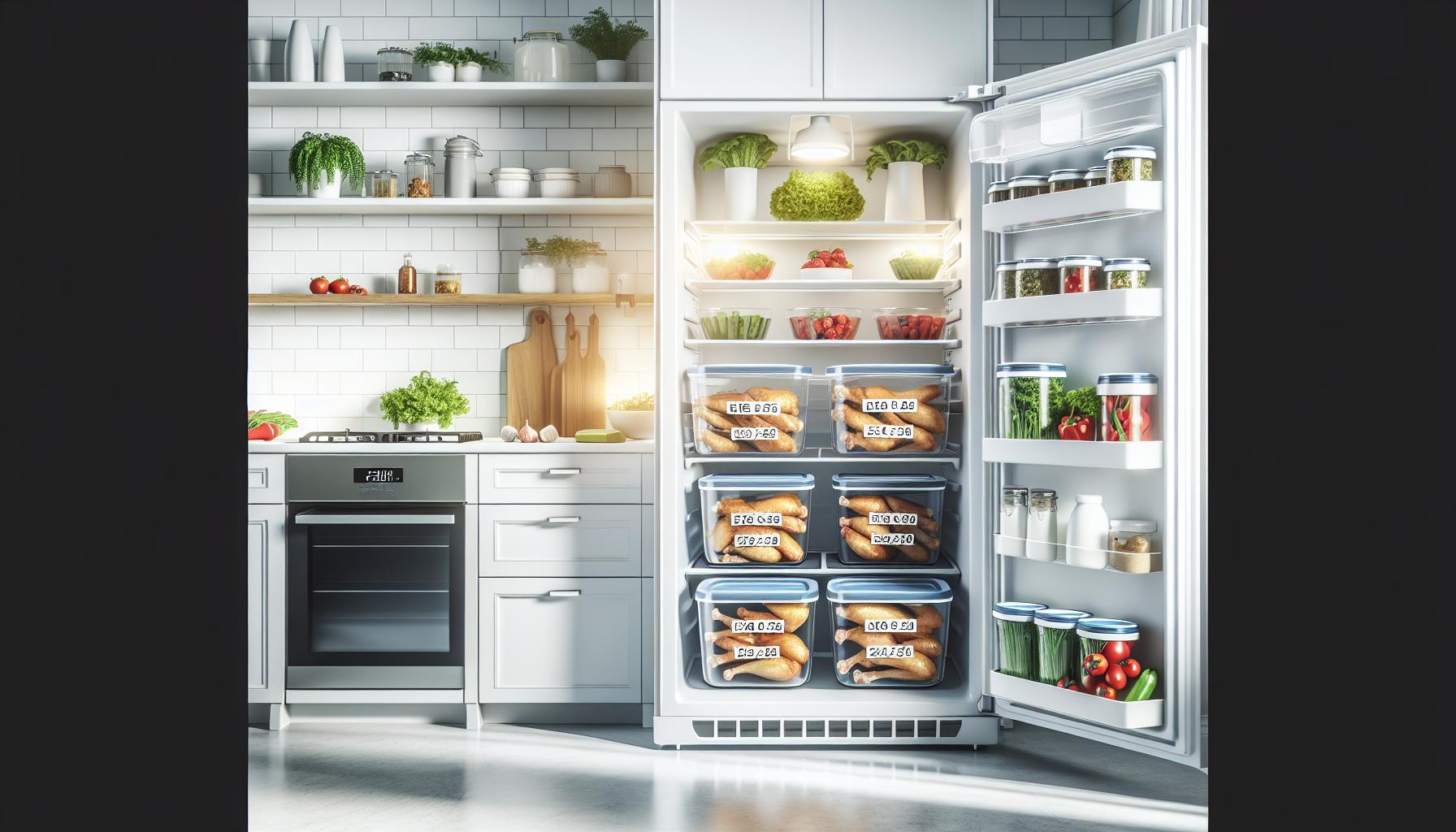
Signs of Spoilage: When to Discard Wings
Determining the freshness of chicken wings is essential to ensure both safety and quality. Deterioration can occur even within recommended storage timelines, and it’s crucial to know when to discard them to avoid foodborne illness. If you notice any of the following signs, it’s best to err on the side of caution and dispose of the wings.
- Off Odors: Fresh chicken should have a mild smell. If the wings emit a sour or strong odor, it’s a clear indicator that they are spoiled.
- Discoloration: While raw wings are typically a light pink, cooked wings should maintain a consistent cooked color. Gray or green patches, or any signs of deep discoloration, suggest spoilage.
- Sticky or Slimy Texture: If the wings feel sticky or slimy to the touch, this usually signifies bacterial growth. Fresh wings should feel raw but not tacky.
- Excessive Ice Crystals (for Frozen Wings): If you find your frozen wings covered in ice crystals or frost, it’s a sign they may have been in the freezer for too long, affecting quality.
Safe food handling includes regularly checking your stored chicken wings. Remember, when in doubt, it’s better to discard them than risk consuming spoiled food. Following these guidelines will help ensure that every meal is not only delicious but also safe for you and your loved ones.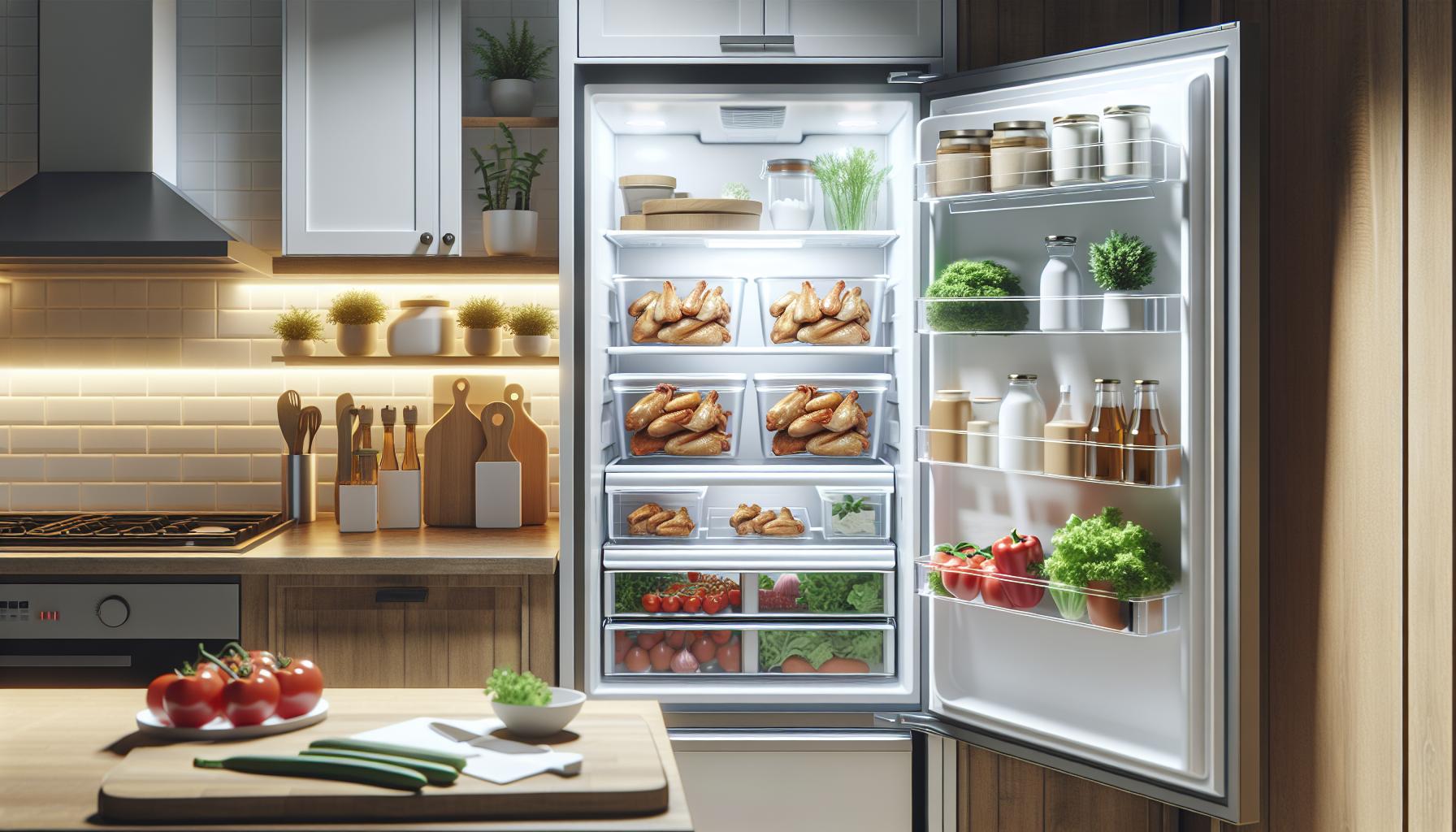
Best Practices for Storing Chicken Wings
Storing chicken wings properly is crucial not just for maintaining their delicious flavor but also for ensuring food safety. Following best practices when it comes to storage can significantly extend the shelf life of your wings and keep them safe for consumption. Raw chicken wings can be kept in the refrigerator for one to two days, while cooked wings can last three to four days. To enjoy your wings, you must pay close attention to how you store them.
When storing raw chicken wings, place them in the coldest part of the refrigerator, typically the bottom shelf. It’s best to keep them in their original packaging. If you’ve already opened the packaging or if the wings are thawed from frozen, transfer them to an airtight container or wrap them tightly in plastic wrap. This helps prevent cross-contamination and protects them from exposure to other foods that could cause spoilage. Always label the container with the date you stored it, as this helps ensure you use them within the recommended time frame.
For cooked chicken wings, allow them to cool to room temperature before refrigerating, but don’t leave them out for more than two hours to avoid bacterial growth. Like raw wings, store cooked wings in an airtight container or tightly covered with foil or plastic wrap. If you plan on keeping leftovers for longer, consider freezing them as they generally last up to four months in the freezer while still maintaining their quality.
Lastly, keep your refrigerator’s temperature at or below 40°F (4°C) to slow bacterial growth. Regularly check that your wings are stored correctly and discard them if they have been in the fridge longer than the recommended times. By following these guidelines, you can enjoy your chicken wings safely and without worry.
Freezing Chicken Wings: A Quick Guide
Freezing chicken wings is a fantastic way to ensure you never waste leftovers and can enjoy them later without compromising quality. When done correctly, chicken wings can maintain their flavor and texture for up to four months in the freezer. To achieve this, it’s crucial to prepare and store them properly from the get-go.
Begin by ensuring your wings are thoroughly cooked and cooled to room temperature. Place them in an airtight container or a freezer-safe plastic bag, removing as much air as possible before sealing. This prevents freezer burn and helps preserve the wings’ taste. For an added layer of protection, consider wrapping the container or bag with aluminum foil or placing it in a second bag. Always label your packages with the date to help keep track of freshness.
When you’re ready to enjoy your frozen chicken wings, the safest way to defrost them is in the refrigerator overnight. This method allows for gradual thawing, minimizing bacterial growth. If you need to defrost them more quickly, you can use the microwave, but be aware that this may partially cook the wings, which could alter the texture. After thawing, consume the wings within 1-2 days if left in the fridge, ensuring they remain safe to eat while retaining the best flavor.
In summary, freezing chicken wings not only extends their lifespan but also provides you with a convenient option for meals in the future. By following proper storage practices and thawing methods, you can continue to enjoy delicious wings at any time.
Reheating Leftover Chicken Wings Safely
When it comes to enjoying leftover chicken wings, reheating them safely is paramount to ensure a delicious and worry-free meal. Proper reheating not only preserves their flavor and texture but also protects you from foodborne illnesses. Leftover chicken wings can be safely stored in the fridge for up to four days after cooking. However, it’s vital to reheat them correctly to enjoy them at their best.
One of the most effective ways to reheat chicken wings is using an oven. Preheat your oven to 350°F (175°C) and place the wings on a baking sheet lined with aluminum foil or parchment paper. For added crispiness, you can arrange the wings in a single layer and cover them loosely with foil for the first half of the reheating process then remove it to allow the skin to crisp up. Heat for about 10-15 minutes, turning them halfway through to ensure even cooking. This method brings back their original crunch and warmth.
If you’re in a hurry, the microwave is a quick alternative; however, be cautious as it may lead to rubbery texture. Place the wings on a microwave-safe plate, covering them with a damp paper towel to retain moisture. Heat them in one-minute intervals until they reach an internal temperature of 165°F (74°C) for safe consumption. Remember to let them rest for a minute before digging in, as the heat will distribute evenly throughout.
For a unique twist, consider using an air fryer. Preheat the air fryer to 360°F (180°C) and place the wings in a single layer, avoiding overcrowding to allow the hot air to circulate effectively. Cook them for about 5-8 minutes until they are crispy and heated through, which can make for an especially delightful leftover experience.
Regardless of the method you choose, ensuring that the wings reach a safe internal temperature is essential. Use a food thermometer to check that they have reached the recommended temperature of 165°F (74°C). This simple measure will keep you safe while satisfying your cravings for those scrumptious wings.
Safe Marinating: Time and Temperature Tips
To enhance the flavor of chicken wings, marinating is a popular method, but it’s essential to do it safely to prevent foodborne illnesses. One key guideline is to marinate chicken wings in the refrigerator, not at room temperature. Marinating at room temperature can allow bacteria to multiply quickly, leading to contamination. The optimal temperature for marinating chicken is below 40°F (4°C) to keep the wings safe while allowing the flavors to infuse.
When it comes to timing, chicken wings should ideally be marinated for at least 30 minutes to allow the flavors to penetrate. However, for an even richer taste, consider marinating them for 2 to 6 hours. If you need to marinate them longer, up to 24 hours is acceptable, but it’s crucial not to exceed this time as the meat can start to break down excessively, which can affect the texture. Remember to always use a non-reactive container, such as glass or food-safe plastic, to avoid chemical reactions that can occur with metal containers.
After marinating, be sure to discard the leftover marinade or bring it to a boil before using it as a sauce, as it may contain harmful bacteria from the raw chicken. Following these safe marinating practices not only enhances the flavor of your chicken wings but also ensures a delicious and safe meal for you and your guests.
The Importance of Food Safety in Storage
To ensure that chicken wings remain safe to eat, understanding food safety in storage is paramount. Chicken wings, like other poultry, are particularly vulnerable to bacterial growth if not stored correctly. According to the USDA, raw chicken should always be kept in the refrigerator at or below 40°F (4°C). When properly stored, raw chicken wings can last for about one to two days, while cooked wings can be safely consumed for up to four days.
Maintaining a clean and organized refrigerator is a crucial step in food safety. Store chicken wings in their original packaging or transfer them to an airtight container to prevent cross-contamination with other foods. It’s also helpful to place raw wings on the bottom shelf to avoid any juices dripping onto other items, which could spread harmful bacteria. Remember to label your storage containers with the date, so you can keep track of how long they’ve been in the fridge.
Signs of spoilage are vital indicators that it’s time to discard chicken wings. Look out for changes in color, texture, or the presence of any off-putting odors. Fresh chicken should be pink, with a slight sheen, and should not feel slimy. If you notice any of these spoilage signs, it’s best to err on the side of caution and dispose of the wings to avoid any foodborne illness.
In summary, prioritizing food safety in the storage of chicken wings not only protects your health but also enhances your culinary experience. By adhering to proper refrigeration guidelines and recognizing spoilage signs, you can enjoy your delicious wings with confidence.
Culinary Uses for Leftover Chicken Wings
Leftover chicken wings are a treasure trove of culinary possibilities, providing both convenience and flavor. Instead of letting them go to waste after a gathering or meal, consider the many ways you can creatively repurpose these tasty morsels while ensuring food safety. With proper storage, cooked chicken wings can last in the refrigerator for up to four days, presenting you with ample time to explore their uses in subsequent meals.
One delightful way to use leftover wings is to incorporate them into salads or grain bowls. Shred the meat off the bones and toss it with mixed greens, cucumbers, and your favorite vinaigrette for a quick and easy meal. You can also add some of the wing sauce to the shredded chicken for an extra punch of flavor. Alternatively, wings can enhance pasta dishes; simply add the shredded meat to your spaghetti sauce or toss it with your choice of pasta for a hearty meal.
Moreover, chicken wings can shine in soups and stews. Just add the leftover wing meat to a simmering broth along with vegetables and grains. This not only makes for a comforting bowl but also infuses the broth with rich flavors from the wings. If you’re looking for something more festive, consider creating buffalo chicken dip by mixing shredded wing meat with cream cheese, hot sauce, and cheddar cheese, then baking until bubbly. Serve it with celery sticks or tortilla chips for a crowd-pleasing appetizer.
Don’t forget the all-important step of ensuring food safety when reheating or repurposing leftover wings. Always store your chicken wings in airtight containers and consume them within four days. When reheating, make sure they reach an internal temperature of 165°F (74°C) to ensure they’re safe to eat. By embracing culinary creativity with your leftover chicken wings, you not only reduce food waste but also treat yourself and others to delicious and innovative meals.
Tips for Meal Planning with Chicken Wings
Planning meals with chicken wings can be both enjoyable and resourceful. By incorporating these versatile staples into your meal planning, you can maximize flavor while ensuring food safety and reducing waste. When well-prepared and stored properly, cooked chicken wings can be a delightful addition to a variety of dishes throughout the week.
To start with, always keep track of your chicken wing storage duration. Cooked chicken wings can safely be stored in the refrigerator for up to four days. This timeframe allows you to creatively repurpose leftovers without concern for spoilage. Consider creating a meal plan that incorporates chicken wings on the first day of cooking, followed by dishes that creatively use the leftovers in subsequent meals. For instance, after having baked wings with your favorite sauce, shred any leftover meat for use in tacos or quesadillas the next day.
Utilizing a variety of cooking techniques and flavors can help maintain excitement around your meals. Try different marinades or spices when preparing your wings to complement various cuisines. A spicy buffalo style one evening could be followed by sweet-and-sour wings for a different taste experience the next. Utilizing wings in salads, soups, or pasta dishes is another great way to incorporate them into your meal plan. You can also make a batch of chicken wing stock using the bones to enhance soups or sauces, ensuring that every part of the wings is utilized effectively.
Lastly, be mindful of reheating practices. When you are ready to enjoy your leftovers, ensure they reach an internal temperature of 165°F (74°C) to guarantee safety. By setting a schedule that allows you to actively consume your chicken wings within this safe window, you align both meal convenience and food safety seamlessly, allowing you to enjoy your culinary creations with peace of mind.
Frequently Asked Questions About Chicken Wing Storage
Understanding proper storage for chicken wings is essential for ensuring both safety and flavor. When left uneaten, many wonder how long these tasty morsels can be kept in the fridge without compromising health. Cooked chicken wings can be safely stored in the refrigerator for up to four days. Mark your calendar or label your container with the date they were cooked to keep track of their freshness. If you haven’t consumed them within this period, it’s best to discard them to avoid any risk of foodborne illnesses.
Still have questions? Here are some common inquiries regarding chicken wing storage:
How can I tell if my chicken wings have spoiled?
Checking for spoilage is straightforward. Look for changes in color (grayish or greenish hues), an off-putting odor, or a slimy texture. If any of these signs are present, it’s safer to throw the wings away.
Can I store chicken wings in any type of container?
Airtight containers or resealable bags are the best for storing chicken wings in the refrigerator. This helps to prevent the meat from absorbing odors and keeps it moist. Make sure to remove as much air as possible to maintain freshness.
What should I do if I have leftovers beyond four days?
If you know you won’t consume your chicken wings in time, consider freezing them. Properly frozen wings can last 3 to 6 months. Wrap them tightly in freezer-safe bags, removing as much air as possible, and label with the date. When ready to enjoy, thaw them in the refrigerator for 24 hours before reheating.
Is it safe to eat chicken wings after reheating?
Absolutely! Just ensure that when reheating, they reach an internal temperature of 165°F (74°C) to eliminate any bacterial growth. This way, you can safely enjoy your favorite dish again without worries.
With these guidelines, you can enjoy chicken wings safely and savor the delicious flavors while minimizing food waste. Always prioritize food safety to make your culinary experience as enjoyable as possible.
Q&A
Q: How can I tell if chicken wings have gone bad?
A: To determine if chicken wings have spoiled, check for an off smell, discoloration, or a slimy texture. If any of these signs are present, discard the wings to ensure food safety. For more on spoilage signs, refer to our section on “Signs of Spoilage: When to Discard Wings.”
Q: Can cooked chicken wings be stored in the fridge?
A: Yes, cooked chicken wings can be stored in the fridge for up to 3-4 days. Ensure they are in an airtight container to maintain freshness. For detailed storage guidelines, check our article section on “Understanding Chicken Wing Storage Guidelines.”
Q: Can I eat chicken wings that were left out overnight?
A: No, chicken wings left out at room temperature for more than 2 hours should be discarded. Bacteria can grow rapidly at room temperature, making them unsafe to eat. For more safety tips, see our section on “The Importance of Food Safety in Storage.”
Q: How can I safely reheat leftover chicken wings?
A: The safest way to reheat leftover chicken wings is in the oven at 350°F (175°C) until the internal temperature reaches 165°F (74°C). This ensures they are heated evenly and safely. For more reheating tips, explore our section on “Reheating Leftover Chicken Wings Safely.”
Q: How should I freeze chicken wings for long-term storage?
A: To freeze chicken wings, place them in an airtight freezer bag or container. Remove excess air to prevent freezer burn and label with the date. They can last up to 6 months in the freezer. Check our section “Freezing Chicken Wings: A Quick Guide” for more details.
Q: What is the best way to store leftover chicken wings in the fridge?
A: Store leftover chicken wings in an airtight container or tightly wrapped in foil or plastic wrap. This helps maintain moisture and prevents odors from other foods from affecting them. For more storage practices, refer to “Best Practices for Storing Chicken Wings.”
Q: How long can I marinate chicken wings before cooking?
A: Chicken wings can be marinated safely in the refrigerator for up to 24 hours. Longer marinating times can lead to a mushy texture, so it’s best to follow recommended times. For safe marinating tips, see our section on “Safe Marinating: Time and Temperature Tips.”
Q: Is it safe to thaw chicken wings in the fridge?
A: Yes, thawing chicken wings in the fridge is the safest method. They can be stored in the fridge for up to 1-2 days after thawing. This allows for safe handling and preparation. For more thawing methods, consider our article section on “Understanding Chicken Wing Storage Guidelines.”
To Conclude
Now that you know how long chicken wings last in the fridge, you can enjoy your favorites with confidence! Remember, for optimal safety, consume cooked chicken wings within 3-4 days and always store them in an airtight container. If you’re curious about elevating your chicken game, check out our guides on perfecting roast chicken or explore 50 delicious chicken recipes your family will love.
Don’t let your leftovers go to waste; try some new recipes or add them to a fresh salad for a quick meal! If you found this article helpful, consider joining our newsletter for more food safety tips and culinary inspiration. Your next delicious dish is just a click away-keep exploring our site for all your cooking needs!



